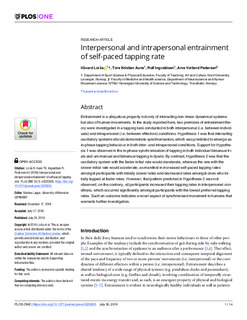Interpersonal and intrapersonal entrainment of self-paced tapping rate
Journal article, Peer reviewed
Published version

View/
Date
2019Metadata
Show full item recordCollections
Abstract
Entrainment is a ubiquitous property not only of interacting non-linear dynamical systems but also of human movements. In the study reported here, two premises of entrainment theory were investigated in a tapping task conducted in both interpersonal (i.e. between individuals) and intrapersonal (i.e. between effectors) conditions. Hypothesis 1 was that interacting oscillatory systems should demonstrate synchronisation, which was predicted to emerge as in-phase tapping behaviour in both inter- and intrapersonal conditions. Support for Hypothesis 1 was observed in the in-phase synchronisation of tapping in both individual bimanual trials and uni-manual and bimanual tapping in dyads. By contrast, Hypothesis 2 was that the oscillatory system with the faster initial rate would decelerate, whereas the one with the slower initial rate would accelerate, as manifest in increased self-paced tapping rates amongst participants with initially slower rates and decreased rates amongst ones who initially tapped at faster rates. However, that pattern predicted in Hypothesis 2 was not observed; on the contrary, all participants increased their tapping rates in interpersonal conditions, which occurred significantly amongst participants with the lowest preferred tapping rates. Such an outcome indicates a novel aspect of synchronised movement in humans that warrants further investigation.